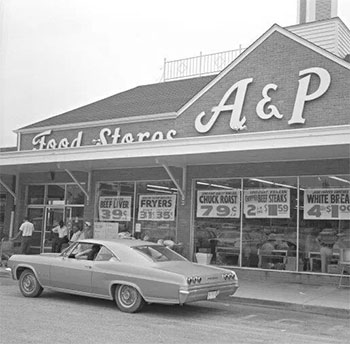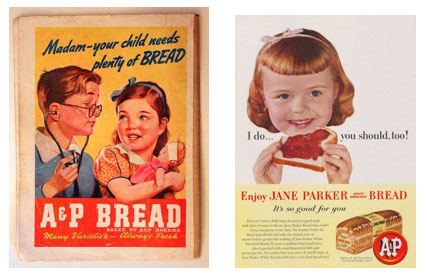Life & Island Times: Bread
It was a typical bitterly cold, slate gray skied, late December 1969 afternoon in South Bend, Indiana. I was working at the downtown A&P store stocking shelves and running a cash register, when I came upon something that affected me profoundly.

A small unkempt child had torn and bitten open a plastic wrapped loaf of store brand sandwich bread and was stuffing it in her mouth. She was sitting on an empty bottom shelf between large format cans of sweet potatoes and tomatoes in the vegetable aisle, trying to hide from those who might take away her loaf.

1938 (l) and 1950s (r) ads for A&P bread
Previously when stocking the shelves, I had occasionaly discovered the aftermath of similar eating forays, but had never seen what I was seeing in front of me. None of the shoppers who passed us by seemed to notice or care. For them it was nothing special or out of the ordinary. The child was dressed in worn winter clothes, mismatchced socks poked out of her hand-me-down shoes, and her upper lip was caked with the dried leavings of a runny nose.
Gathering myself, I slowly concluded that what I was seeing was more than just a hungry child. She was the embodiment of poverty and misery. That long ago wretched scene caused me to take her by the hand along with her loaf to the front door and tell her to go home with her bread. Store policy was to confiscate the pilfered goods. I could not. My assistant manager said nothing despite shaking his head.
The store threw out or returned to the central A&P baked goods supplier expired bread twice a week. The loaves numbered in the many dozens weekly, not counting all the other expired bread products. The waste of fresh vegetables and fruit was monumental by comparison.
Hard winter stayed with us for three or four months every year, but this scene was likely a year-round occurrence at this little market I concluded as I rode my motorcycle back home that night. For whatever reasons — unemployment, substance abuse, broken families — folks had no money, kitchen pantries became empty and children went hungry. No work. No money, No bread. No bread literally. American children?!?
This was not the last time . . . I came across the theft of bread many more times as the weeks went by . . . to the point that it became, at least to me, a disaster . . . statistics would much later document that many petty thefts by inner city juveniles had hunger as the proximate cause.
The idea that the America that had won two world wars and grew more food than the country could eat had paupers who were starving was mind numbing.
I proposed that our store donate to local soup kitchens or give away directly to kids our stale bread but was disabused of that notion by management. Torn open bread loaf bags became a symbol of an unexpected bitter harvest of hungry children. I wondered if the then “guns and butter” American economy was an oxymoron. I still wonder why local grocery stores were not ransacked and cleaned out by starving mobs of kids. Instead, they came in ones and twos and fed themselves when employees were otherwise occupied. I never seized a child’s bread. I just gently escorted them and their bread to the front door. Management started to look the other way.
Bread eating hungry children thus became a sharp marker of stark but hidden economic conditions that were present during the boom times of the late 1960s.
After a while it was apparent that the country was divided into people who could afford to eat three squares a day including soft white bread and the poor whose children roamed grocery store aisles eating anything they could tear open and wolf down. Rarely did we find them eating candy, cookies, chips or fruit. It was almost always bread.
They were truly starving wolves eating store brand bread slice by slice. Empty bread loaf bags became a barometer of neighborhood child hunger. Their numbers always increased as the month came to a close and family budgets dwindled. This was an unplumbed world of heartbreak and sadness that seemed unending and expanding despite more freely flowing federal food program aid dollars.
Why? I dunno. Because . . . because the poor we will always have with us?
Despite working in community food programs during the past two plus decades, I remain haunted by the trail of crumbs from that loaf of bread the little girl was eating long ago.
Some flour, oil, salt and water — days later
coagulated and hardened into day old cement loaves
They’d settle for that
Little empty stomachs creeping through the aisles
Biting open bags, leaving them in shreds
Secretly and quickly devour it
No matter how tiny, the crumbs of bread
. . . and farther beyond those shelves,
rags and hunger, a world exists
But we, checkmated
by management
rules — know it not — are
like machine guns guarding a prison yard
and children condemned to starvation
Copyright © 2017 From My Isle Seat
www.vicsocotra.com
